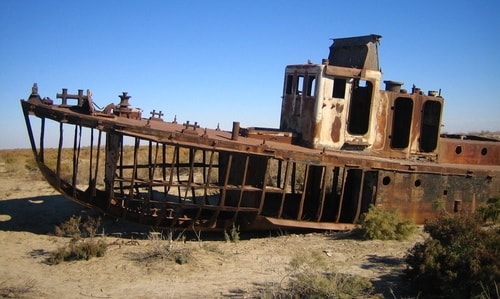You are here
Ecological tourism on Aral.
Travel on the car across Uzbekistan.
The Kyzlkum and Karakum deserts of Uzbekistan offer visitors spectacular settings where the horizons stretch endlessly and the bustle of carpet sellers in Bukhara and Samarkand is left far behind.
Here it is possible to live in traditional nomadic yurt tents and travel by camel or horse, eating around camp-fires and enjoying traditional folk songs under the stars. For the adventurous, it is also possible to cross the desert and to reach the shores of the Aral Sea, an opportunity which may not be around for much longer.
The Aral used to be the fourth biggest inland lake in the world and is now the eighth. Since 1960 it has lost more than 60% of its area and 80% of its volume. The sea level has dropped eighteen metres on account of intensive upstream irrigation schemes for growing cotton, consuming more than 90% of the natural flow of water from the Tien-Shan mountains along the Syr Darya and Amu Darya rivers, the Jaxartes and Oxus of ancient times.
Its shrinking has been described as the worst man-made ecological disaster on the planet and has resulted in the total collapse of a fishing industry that used to yield 44,000 tonnes per year.
The southern shore has now shrunk 150 kms and some estimate that by 2015 it could disappear altogether. Along the former shoreline salt has accumulated due to evaporation. Blown by north-easterly winds it has led to the rapid spread of desertification damaging the surrounding agricultural areas and leading to serious health consequences among rural communities.
Flying in to Nukus, the nearest major city, the expanse of salt covering the earth looks in parts like fresh snowfall. Most visitors wishing to witness the dramatic decline of the Aral Sea do so from the air on short round trip flights from Nukus. We decided to drive and to camp on the shore of the Aral itself.
A short distance from Nukus we arrived at Muinack, once a thriving port with its own fleet of fishing boats and a canning factory; now stranded in the desert 150 kms from the water's edge.
A small community still live in Muynack, almost outnumbered by the number of rusting fishing boats left stranded on the sand. Visually dramatic, it creates a stunning impression of desolation and the potential for devastation caused by man's disregard for the balance of nature.
The locals say that if every visiting diplomat and journalist brought a bucket of water with them, the shoreline would be as it was forty years ago. Their dark humour is all they have left.
From Muinack a tough track by 4WD meanders across the desert floor and up an escarpment, across complete emptiness broken only by the occasional abandoned gas rig, leaning like a heap of old splints, or hawks flying overhead.
The crunch under foot stepping out of the car comes from the millions of seashells - a reminder of the seemingly impossible, that only forty years ago all of this was covered in water as far as the horizon.
After five hours crossing the former seabed, we reached the edge of the escarpment and the hazy blue of the horizon seemed to dip until we realised we were looking at the Aral Sea itself.
As the haze lifted, it was a remarkably beautiful and very moving sight to see the deep blue and the reflection of the sun catching on the waves. The Aral was still alive and appeared like a noble survivor, wounded and abandoned to its fate.
The dust and heat of the journey made the waves particularly appealing so we hurried to the shoreline. Instead of a sandy beach, our feet broke though a crust of salt into a thick gluey sludge that made reaching the water difficult.
It is said that the mineral content of the water is now seven times higher than 40 years ago and that the sludge is caused by the growing concentration of salt combining with residues of pesticides and fertiliser that have run off the cotton fields.
It was a unique opportunity, and as my days of fathering children are over, I thought what harm could be done and waded out! It was remarkably difficult as my legs sank deeper into the dark grey mud but at last I was swimming, my mouth firmly shut, alone in a vast natural landscape of desert, sea and sky.
The concentration of salt in the water is now such that when I returned to the beach and dried off, I was entirely covered with fine white salt powder that was very uncomfortable until I showered under bottled water.
That night we drank malt by the campfire and felt utterly minuscule under the awesome canopy of glittering stars and also that it was a unique privilege to be there. We woke to a wondrous sunrise and then bade a fond farewell to the Aral.
Our Uzbek guides were bemused at the lengths foreigners will go to find emptiness, or to get away from one another, but were blearily contented after a long night of vodka and shashlik, as we rattled our way home.
Authority:
Neville McBain. http://www.discovery-central-asia.com
Photos
Alexander Petrov.







